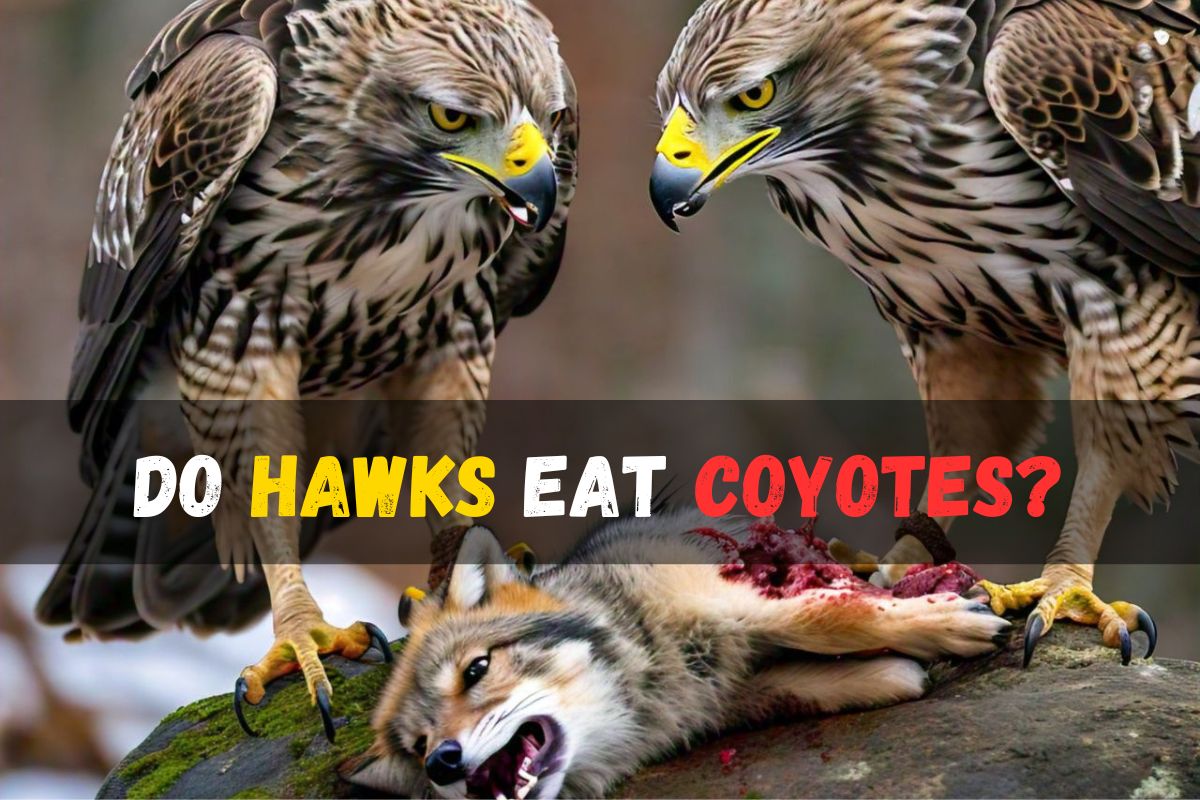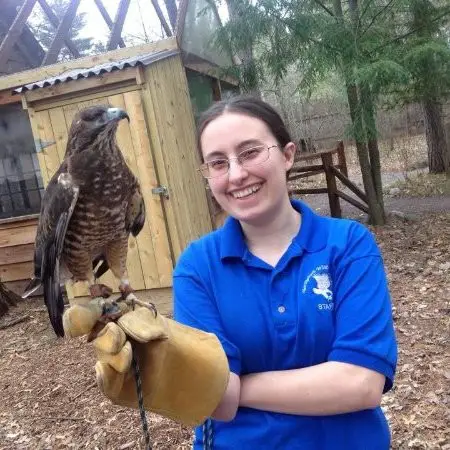Do Hawks Eat Coyotes?
Hawks occasionally prey on coyotes, primarily targeting young, injured, or deceased individuals. Mature red-tailed hawks, equipped with formidable strength, have been observed to capture small-sized coyotes, carrying them away for consumption successfully. However, this feat proves challenging for younger hawks, as they need help overcoming adult coyotes’ size and strength. Consequently, most hawks resort to scavenging on deceased coyotes found on the ground, avoiding the risks associated with confrontation. The adaptability of hawks to capitalize on available food sources, including carrion, underscores their survival strategies. Adult coyotes, renowned for their strength and intelligence, deter hawks from attempting to prey on them due to the significant risk of injury. In essence, while instances of hawks preying on coyotes exist, they typically target vulnerable individuals or scavenge on carcasses rather than engage in direct hunting pursuits against formidable adversaries.
Do Hawks Eat Bats?
How do Hawks Attack Coyotes?
Hawks are formidable predators, employing various tactics to hunt down their prey. When tackling coyotes, these birds of prey rely on their aerial prowess and keen hunting instincts to make a successful kill.
Stalking from Above
One of the primary strategies hawks employ when targeting coyotes is to stalk them from above. Hawks possess exceptional eyesight, allowing them to spot potential prey from great distances. From their vantage point in the sky, hawks can scan the landscape for signs of movement, including the telltale silhouette of a coyote. Once they have located their target, hawks will dive down with astonishing speed, using gravity to aid their descent.
Dive and Strike
The dive-and-strike method is a signature move of hawks when attacking prey. With wings folded back to reduce air resistance, the hawk hurtles towards the unsuspecting coyote below. At the last moment, the hawk extends its talons, aiming for a precise strike. With razor-sharp claws, hawks can inflict severe damage to their prey, often targeting vulnerable areas such as the neck or spine.
Ambush Tactics
In addition to aerial assaults, hawks may employ ambush tactics when hunting coyotes. By perching in strategic locations near areas frequented by coyotes, such as open fields or woodland edges, hawks can patiently wait for an opportunity to strike. When a coyote ventures into striking range, the hawk will launch a surprise attack, catching its prey off guard.
Coordinated Attacks
While hawks are typically solitary hunters, there have been instances where multiple hawks coordinate their efforts to take down larger prey, including coyotes. By working together, hawks can overwhelm their target with a barrage of attacks from different angles, increasing their chances of success.
Do Hawks Eat Ducks?
Do Hawks Eat Other Carnivores?
Hawks generally do not prey on other carnivores as a primary food source. They typically hunt small mammals, birds, insects, and occasionally reptiles or amphibians. However, in rare cases or under specific circumstances such as scarcity of typical prey, territorial disputes, or opportunistic encounters, hawks may engage in intra-specific predation or scavenge from other carnivores’ kills.
Do Hawks Eat Fish?
What Is A Hawk’s Favorite Food?
Red-Tailed Hawks:
Red-tailed hawks, known for their keen eyesight and soaring abilities, occasionally include coyotes in their diverse diet. While their primary prey consists of smaller mammals like rodents and rabbits, red-tailed hawks have been observed opportunistically targeting juvenile or injured coyotes. They typically dive from above, using their sharp talons to grasp the prey securely before carrying it off to a feeding site.
Harris Hawks:
Harris hawks exhibit unique cooperative hunting behaviors, making them formidable predators. While coyotes are not their primary targets, in certain circumstances, particularly when hunting in groups, Harris hawks have been documented harassing and attacking coyotes to defend their nests or secure food. Their agility and teamwork enable them to outmaneuver and intimidate larger predators like coyotes.
Ferruginous Hawks:
Ferruginous hawks, well-adapted to open grasslands and prairies, primarily hunt small mammals like ground squirrels and rabbits. However, they are known to prey on young or injured coyotes occasionally. With their powerful talons and broad wingspan, Ferruginous hawks can swiftly swoop down on unsuspecting prey, including coyotes, making them a sporadic but effective predator in specific ecosystems.
Broad-Winged Hawks:
Broad-winged hawks prefer densely forested habitats where they hunt smaller prey such as mice, voles, and amphibians. While they are not commonly associated with preying on coyotes due to their habitat preferences, there have been isolated reports of Broad-winged hawks targeting young or weakened coyotes, particularly in areas where their ranges overlap. Their hunting strategy involves swift and stealthy ambushes from perches within the forest canopy.
Northern Goshawks:
Northern goshawks are skilled hunters known for their agility and speed in flight. While they typically prey on birds and small mammals, including squirrels and rabbits, there have been rare instances where they’ve been observed targeting coyotes, particularly juveniles or injured individuals. With their sharp talons and powerful beaks, Northern goshawks can deliver precise strikes, often catching their larger prey off guard.
Do Hawks Eat Mice?
Health and nutritional benefits of eating Coyotes to Hawks
Integrating coyotes and hawks into one’s diet may sound unconventional, but these wild predators offer a surprising array of health benefits. Beyond the novelty factor, their consumption can provide unique nutritional advantages, albeit within specific cultural, ethical, and legal considerations.
Protein-Rich Source
Coyotes and hawks are rich in protein, making them a valuable addition to diets that meet protein requirements. Protein is crucial for muscle repair, immune system function, and overall growth and development.
Rich in Essential Nutrients
Both coyotes and hawks are rich in essential nutrients such as iron, zinc, and B vitamins. Iron is necessary for oxygen transport in the body, while zinc plays a vital role in supporting immune function and wound healing. B vitamins play a role in energy metabolism and neurological function.
Low in Saturated Fat
These wild meats tend to be leaner than traditional livestock, making them lower in saturated fat. Lower saturated fat intake is associated with reduced risk of heart disease and improved cholesterol levels.
Source of Omega-3 Fatty Acids
While not as abundant as in fatty fish, coyotes and hawks may contain omega-3 fatty acids, mainly if they prey on fish or consume a varied diet. Omega-3s offer numerous cardiovascular benefits and support brain health.
Potential Immune-Boosting Properties
Consuming wild game like coyotes and hawks exposes individuals to various microbes and antigens, potentially bolstering the immune system’s ability to respond to pathogens. However, proper cooking and handling are crucial to minimize the risk of foodborne illness.
Impact of Eating Coyotes by hawk on the ecosystem
It can have various impacts on the ecosystem that are worth exploring.
Predator-Prey Dynamics:
When hawks consume coyotes, it influences the delicate balance of predator-prey dynamics. Coyotes are typically predators, preying on smaller mammals like rabbits and rodents. However, when they become prey for hawks, it can disrupt their population control on smaller mammals, potentially leading to an increase in those populations.
Competition and Resource Allocation:
Coyotes and hawks compete for similar food resources, such as small mammals and birds. The predation of coyotes by hawks could reduce competition for these resources, allowing other species in the ecosystem to thrive. This shift in resource allocation can have cascading effects on various trophic levels within the ecosystem.
Trophic Cascades:
The consumption of coyotes by hawks may trigger trophic cascades, where changes in one species’ population affect multiple trophic levels. For example, a decrease in coyote numbers could increase the populations of their prey species. This, in turn, could impact vegetation dynamics and even alter the behavior of other predators or scavengers in the ecosystem.
Disease Control:
Coyotes can serve as reservoirs for certain diseases, such as rabies or distemper. By preying on coyotes, hawks may indirectly contribute to controlling the spread of these diseases within the ecosystem. This can positively affect the health and stability of other wildlife populations, including those that might otherwise be susceptible to such diseases.
Do Hawks Eat Cats?
FAQ’S
Do lions eat hawks?
Lions are primarily terrestrial predators, focusing on larger mammalian prey such as antelope, zebras, and wildebeests. They do not typically prey on birds of prey like hawks, which is a significant part of their diet. While lions have been observed opportunistically hunting birds, such instances are rare and usually involve ground-dwelling species like ostriches or guineafowl rather than aerial hunters like hawks.
Being agile and swift flyers, Hawks are challenging targets for lions. Additionally, hawks often inhabit areas where lions are not abundant, reducing the likelihood of encounters between the two species. Therefore, it’s safe to say that lions do not regularly eat hawks as part of their diet.


